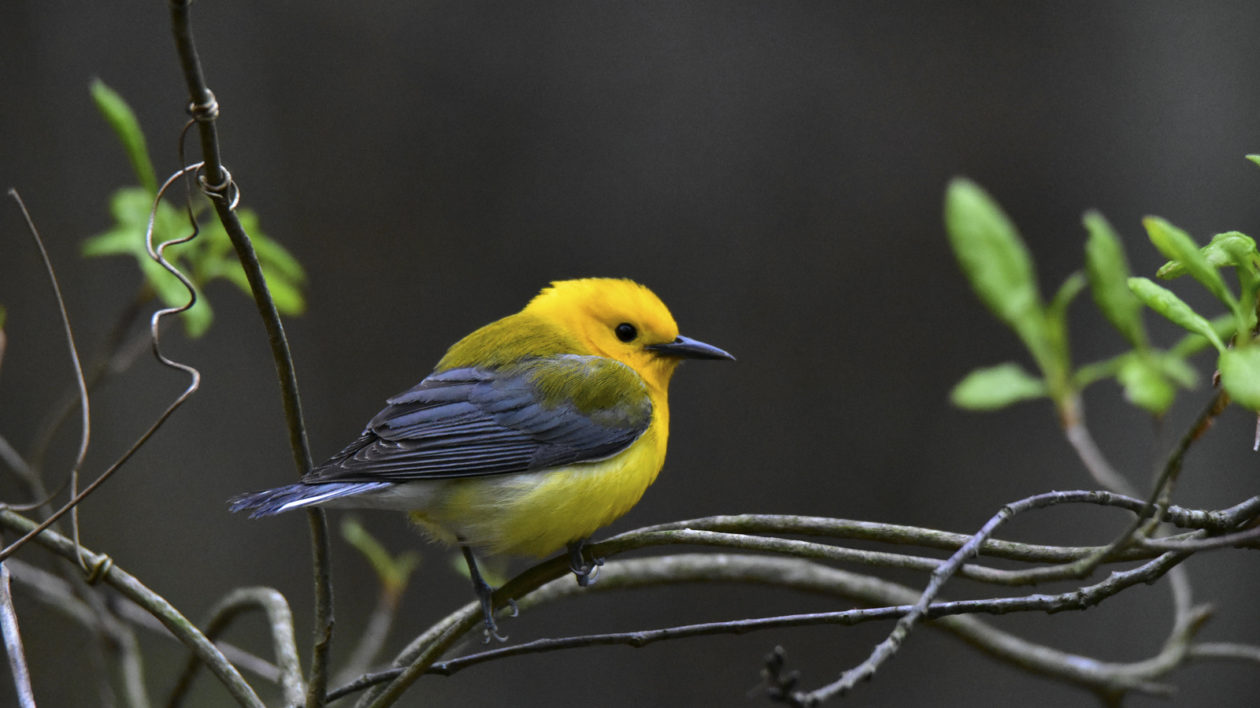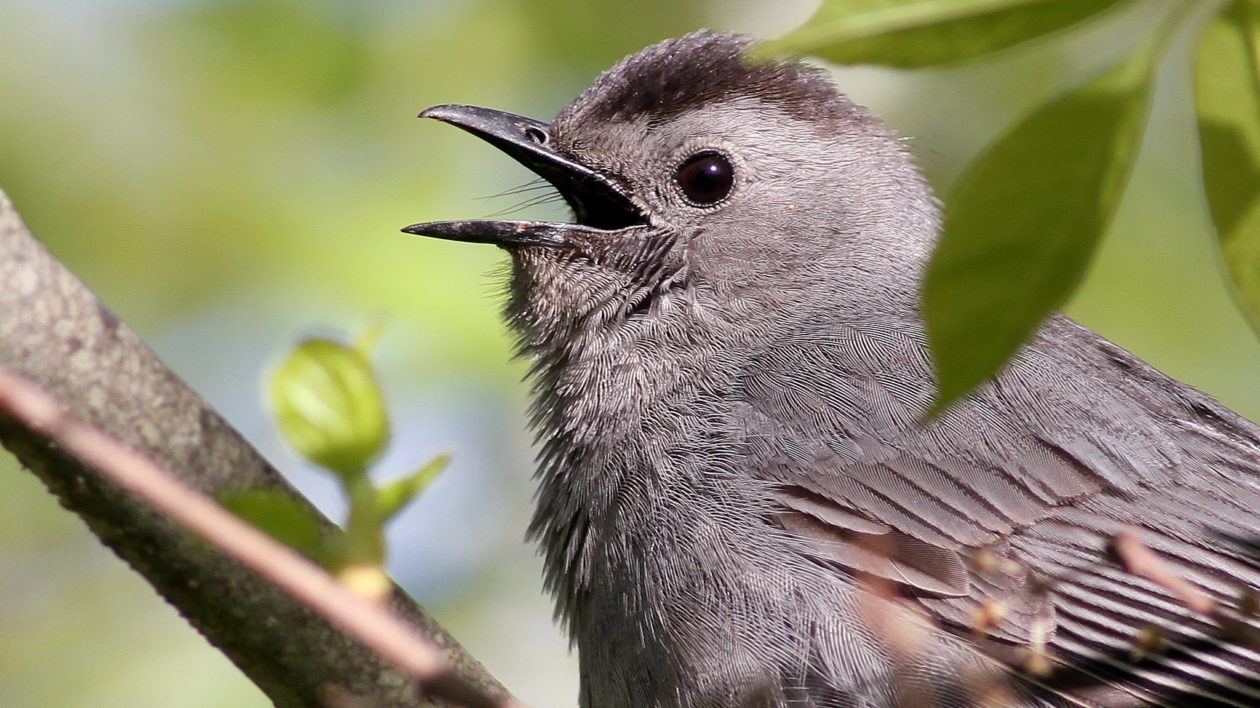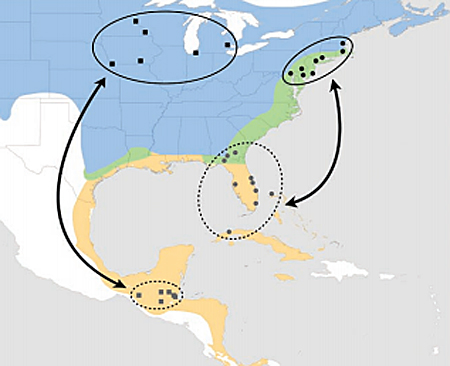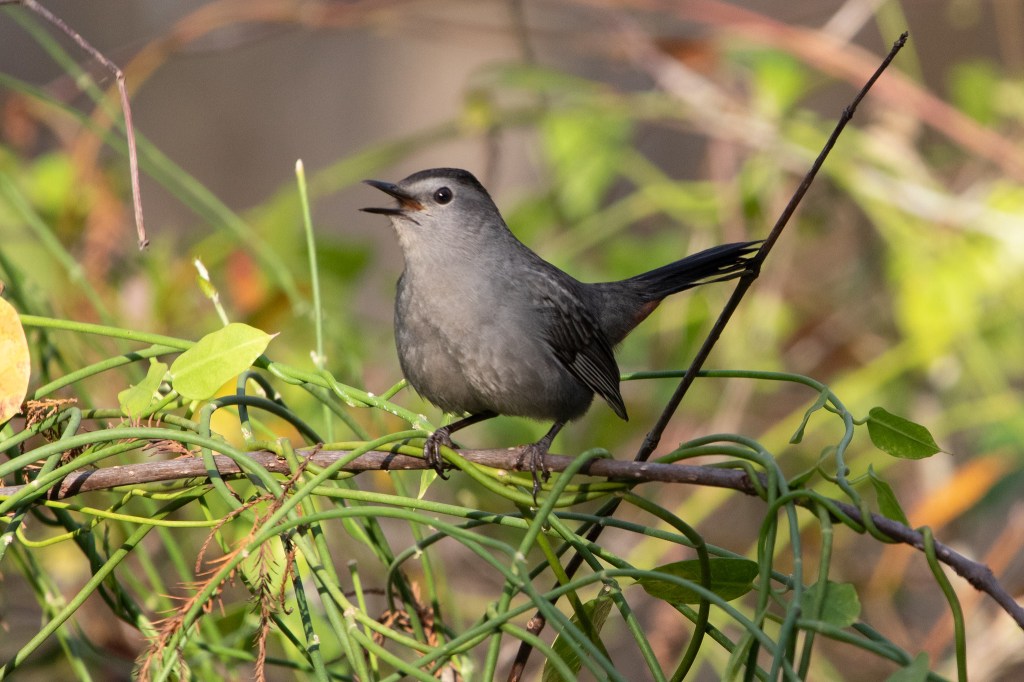Consider the gray catbird: the tropical long-distance migrant that may well be nesting in your backyard this summer.
Gray catbirds are common, so you may not pay them much attention. But look into the research, and you’ll find that this backyard bird is full of surprises. Let’s take a closer look.
As I write this, a gray catbird is singing in my backyard.
It arrived here in New Jersey several weeks ago and may already be building a nest with its mate somewhere in the neighborhood.
I am wondering where my catbird spent its winter – and whether this is the very same catbird that was in my yard last summer. Research on catbirds can help answer these questions.
Every spring, dozens of species of migrant songbirds make their way north from the tropics to settle into nesting habitats across North America. Indeed, half of all North American birds spend their winters south of the U.S. border – from Mexico through South America.
Most of these species are habitat specialists and we might see them in our backyards only briefly during migration as they make their way to more remote places.

The gray catbird, on the other hand, is a migrant from the tropics that is quite happy to claim a breeding territory in a wide variety of shrubby habitats, including suburban backyards.
The catbird singing in your backyard this spring is likely the same one that was there last year. Individual catbirds (and numerous other species) return to the same habitat patch to nest year after year, as long as they are fortunate enough to survive from one season to the next. Studies have shown a roughly 60 percent annual survival rate for catbirds.
If your backyard catbird has a lucky streak, you could see the same bird coming back for many seasons. The longevity record for a catbird is 17 years, 11 months.
This nearly 18-year-old bird was caught and banded as a young of the year in Maryland and miraculously encountered again by banders those many years later in New Jersey.
Banding can confirm the age of birds and also confirm that the bird in your backyard this year is the same one that was there last year.
Participants in programs like Neighborhood Nestwatch can observe their backyard catbirds wearing unique combinations of colored leg bands. These identify each bird as an individual and can be viewed with binoculars. For this project, researchers and participants alike can make observations on the identity and longevity of their catbirds.
Catbirds nest in 46 of the lower 48 United States and across southern Canada. They spend the winter across an equally broad area. A proportion stay in the U.S., where they primarily occupy the Gulf Coast and Florida. Some hearty individuals hang in there as far north as New Jersey.

Others go further south to the tropics – to the forests of Mexico, the Caribbean and Central America. There, they share the woods with jaguar, tapir, fer-de-lance and toucans.
Catbirds return to the same site on the wintering grounds every year as well. Your backyard catbird might spend the winter in the shadow of Mayan ruins in Guatemala or perhaps in the Florida Everglades.

We can make an educated guess on where your backyard catbirds spend the winter thanks to a recent analysis of banding records along with the use of tracking devices.
What this work tells us is that if a catbird breeds in the upper Midwest, it is more likely to be spending the winter in Central America. If it nests in the mid-Atlantic and New England, your catbird is likely spending the winter in Florida or the Caribbean.
As more studies like this one are carried out, we will have a further refined picture of “migratory connectivity” between nesting and winter sites. And we will be able to make even better guesses about where our backyard catbird might be next winter.
“A Few Raisins Give Him the Greatest Delight”
If you want to kick things up a notch for your backyard catbirds this summer, in addition to providing water, you can also offer them fruit.
As the poet Mary Oliver observes in her poem “Catbird”: “But a few raisins give him the greatest delight.”
One of the pleasures of a birding holiday in the tropics is watching birds at fruit feeders. After hours of seeking difficult-to-see skulking birds of the undergrowth and fast-flitting birds of the high tree tops, birding respite can be found at lodges and cafes that maintain fruit feeders for birds. Dozens of species of brightly colored birds come into easy view to eat banana, papaya and citrus at close range.
Catbirds bring a bit of this culture back with them from the tropics and are among the few birds at our northern latitudes that will readily eat soaked raisins, sliced orange and even grape jelly.
Back to my well-fed catbird. Is he the same bird as last year? Without banding him, I can’t know for sure. But I do know that he will do everything within his power to return here.

And return from where?
Maybe it is time to combine science with imagination. The science tells me that he wintered somewhere in Florida or the Caribbean.
But for better spatial resolution, my imagination is saying the Zapata Swamp of Cuba. Listen to what he sounds like there (in the audio file) … and then listen for the catbird in your yard!




Catbirds have been nesting successfully in my yard for over 20 years. We are always happy to see them arrive come spring and enjoy their curious nature. This year however has been somewhat different. There have been two or more pairs trying to make our 1 acre lot their home although only one nest has been found. The nest is in the same location where a pair nested last year… in an oakleaf hydrangea by my front door. There were 4-5 turquoise eggs and as far as I could see, 4 hatchlings. We peeked at them daily; about the 5th day (guesstimate) the nestlings were gone and I am sure they were not mature enough to fledge. The nest appears undisturbed and after searching around they were not found. Parent birds confront us in an accusatory manner, fussing wildly, every time we go out the door as if we have taken the babies! Have you ever heard of this behavior? Could the other Catbirds have abducted them? I haven’t recently seen any cats or other predators around other than an occasional Cooper’s Hawk but the nest is quite secluded. We live in a residential setting. Thanks for any help you might offer. BTW, do you by chance know Edy Goodyear from Ecuador? I met him this spring on a birding outing in NC.
I’ve discovered a catbird nest that’s home to a mom and four chicks in a forsythia bush within two feet of our kitchen window. The chicks have feathers and some nude spots. I think they hatched about six days ago. We’ve installed thick drapes over the window, and I put my camera on a tripod, so that it pokes through a gap in the drapes. I’m getting some really cool pictures of the mom taking care of her babies. I do see a second catbird who hangs out in the vicinity, and I don’t know whether this is the father.
Do the males look any different than the females?
Hi Bob, That sounds like a wonderful set up for photography! Male and female catbirds look alike, but according to the Cornell Lab of Ornithology, the male has a louder song: https://www.allaboutbirds.org/guide/Gray_Catbird/id
I accidentally left a cooked chicken breast on my patio one day and was surprised to see the catbirds pecking at it! I left it there for them all afternoon since they seemed to be enjoying it. Media, PA.
Thoroughly enjoyed reading the essay on catbirds by Joe Smith, PhD. Each year here in Holland Twp, NJ I look forward to the return of the catbirds, whose calls sound as if they are actually calling out to members of our household — Jer-eeeee, Er-in! I’m not sure if the catbird mates are the same two who were here in previous years, but I am seeing some interesting behavior. Whereas the catbirds were initially shy some years back, they eventually decided to join other birds as ground feeders on our patio, especially since I’ve started feeding them nuts. This year they will land very close to me as I come out to feed my morning visitors. Another new and interesting change is that these two catbirds will “follow me” around the property, flying to catch up to me, landing when I stop and flying close to me again when I begin to walk. I’ll now take Dr. Smith’s suggestion and try feeding them soaked raisins in gratitude for their unique character!
We have a catbird that pecks on our windows, drives us crazy. This started happening last June. So I’m thinking it’s the same bird as last spring. The bird is back this week. We live in Massachusetts. I’m curious, have you ever heard of this strange behavior?
Thank you,
Maureen
Hi Maureen, I haven’t heard of a catbird attacking a window specifically, but other species like robins and cardinals are known to attack windows because they are territorial and they think their reflection is another bird in their territory. Here is some info on the problem and what you can do to stop it: http://www.massaudubon.org/learn/nature-wildlife/birds/birds-attacking-windows
I have a beautiful pair of cat birds in my back yard they are eating sunflower seeds. Is that unusual ?
Hi Barbara, As far as I can find out by looking around on trusted bird sites like Cornell & Audubon, that is unusual. The Wild Bird Habitat Store (I’m not sure of their source for the information, so take this part with a grain of salt) suggests this is perhaps not unheard of, especially if the seeds are already cracked open and they are eating the hearts.
We live in Central Florida and have a Cat Bird who is now back for the third year. He shows up around early November. We can hear him early in the morning pecking at his reflection in the mirror on my car or my husband’s truck. We look forward to seeing him each year.
I had a Catbird show up in my yard in Flin Flon, Manitoba on October 30th 2016. It’s now November 2nd and it’s still here! It’s weathered below freezing temperatures and snowstorms. It seems to like oatmeal and peanut butter mixed with premium bird seed but will also eat fruit and jam. What a cutie! I have pictures of it on eBirds.
We have had the pleasure of 2 pairs of catbirds return for the last 4 years. I believe they are the same since they know where the treats are.
This year, a young catbird hit our front window very hard. We heard the bang on the window. We ran out and found the bird on his back and thought he was lost. We gently turned him over, he was still breathing and waited, watching him from a distance for over an hour. He recovered and flew off. We saw him at our fountain the next day. We identified him by his short tail and coloration of his head. He was fine!
They are our favorite bird, so curious and beautiful.
I live in Hopewell Virginia. I enjoy feeding birds. The cat bird is one of my favorites. I believe the same birds come back to my yard each year. I make a mewing sound that attracts them . I put meal worms on the step and they look for them . They also like suet and will fly up to get it underneath the feeder. I have watch them fill their beaks with suet or dry worms and fly off to feed their young.
It is now September 10 and I have not seen a cat bird in about a week. I am wondering if they have migrated south?
Love my cat bird, we call her Miss Kitty. She goes nuts for a half cantaloupe with raisins, and my home made suet. If there is no suet, she will follow me, walking, all over the yard, bitching the whole time! I have a magic dog, Chevy, part german shepherd, part airedale that chases starlings off the suet..Miss Kitty will wait patiently until Chevy dispenses with them, and hops back on it. She will land beside him, and complain if he isn’t doing a proper job. Love her, it would not be the same without being nagged by her!
I live in Central Pennsylvania and one summer a catbird nested in our big bushes and he would come up on our porch even while we sat there and he used the birdbath. Then next spring, we know the same one came back because he came up on the porch again, as if to say hello. But, sadly, he and his mate went across the yard and attempted to nest in the bushes that are right by the road, which is busy because it’s the main road that connects everything. He would sing to his mate every morning. Well, one morning I didn’t hear him and I walked up by the road and crossed it and there was a dead male catbird lying on the side of the road, hit by a car. I was so sad. He was like our little friend. I’ll always remember this experience with that catbird. Other catbirds have since nested in our bushes close to the house. They use the birdbath, but don’t come on the porch.
My Catbirds are very friendly. They seek me out when I am outside in the yard. I don’t feed them or do anything more than whistle to them or talk to them … lol Is this part of their characteristics?
I JUST LOVE CATBIRDS. THEY KEEP THE GARDEN ALIVE WITH THEIR MUSICAL SOUNDS AND LIVELY JUMPING AROUND EVERYWHERE.
IT IS DROUGHTY HERE THIS SUMMER IN NE GA. IT RAINED ONCE THE OTHER DAY AND I WOULD SWEAR THEY ACTUALLY DANCED AROUND THE YARD WHILE TWITTERING THEIR DELITE.
THEY ARE NO TROUBLE AT ALL. I HAVE BEEN DIVE-BOMBED BY MOCKINGBIRDS THIS YEAR SO HAPPY WITH MY MUSICAL CATBIRDS.
Have a catbird couple nesting in my wooded garden in Scarborough Maine. They visit my feeders daily and try unsuccessfully to land on the birch log suet feeders. Saw one selecting sticks for the nest. Catbirds are wonderful conversationalists, will stop and talk with you, answer in their fashion.